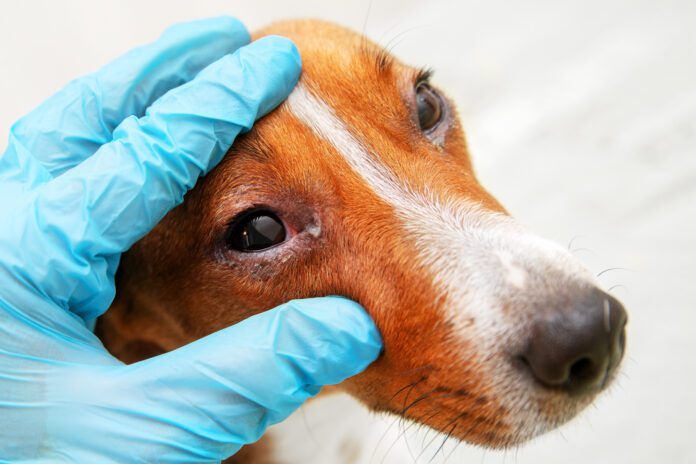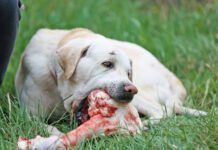You may notice your dog’s eyes look red, and there may be some discharge. He might be squinting. How do you know if this indicates allergies or an eye infection?
Deciding if your dog has an allergic eye reaction or if he is starting with an infection is difficult. Unfortunately, eye problems can go from minor to very serious very quickly. Generally, you can wait overnight, but it is much better to err on the side of caution and schedule a veterinary visit as soon as possible.
Allergic Dog Eye Symptoms
The discharge from your dog’s eyes will vary with allergies versus infections. With allergies, squinting is not common. The usual signs include:
- Clear, liquid discharge
- Red, inflamed conjunctiva
- Rubbing his eyes with his paws or his face along the carpet or grass
- Both eyes affected
- Possible clear nasal discharge
- Dog may sneeze
Allergies tend to be seasonal, just like in people, so think spring and fall for the big allergy seasons. Remember, however, that dogs can also suffer from nonseasonal allergies such as food, medications, and contact allergies, including from things like laundry detergent and household cleaners.
“In my clinical experience, allergic conjunctivitis is characterized initially by significant pruritus (itching) directed at the eyelids and periocular skin, often resulting in alopecia (hair loss), skin ulceration, eyelid swelling and chemosis (swelling of the conjunctiva),” says Thomas J. Kern, DVM, associate professor of ophthalmology at Cornell University’s College of Veterinary Medicine. “Secondary chemosis and mucopurulent discharge due to secondary bacterial infection often accompany these other signs. Affected animals may have generalized cutaneous signs or signs may be localized to around the eyes.”
Infected Dog Eye Symptoms
Eye infections like pink eye tend to be painful. Your dog may resist if you try to clean them or look at them closely. With infections, especially if secondary to trauma, only one eye may be affected. Signs of an infected eye in a dog include:
- Discharge is most likely to be mucoid, thick, and purulent (puslike), although it can be clear, gray, green, or yellow
- Red, swollen, and inflamed conjunctiva
- Dried crusts on the dog’s eyelashes
- Dog may squint and avoid bright light, particularly if the cornea is damaged
- He may rub his eyes, or his face just like with allergies
Causes of an Infected Eye in Dogs
Ocular infections can be caused by many things, often with associated damaged to the conjunctiva or cornea. Once those protective barriers are broken by trauma or foreign bodies, the tissues are ripe for bacterial invasion. Ocular viral infections are often a result of viral respiratory problems. Something as simple as shampoo on your dog’s cornea can lead to an infection and corneal damage. (Think how it stings if you get shampoo in your eye!) Eyelash and eyelid problems, like entropion and ectropion, may cause corneal irritation and lead to infection.
Dog Eye Discharge Diagnosis
If your dog has a veterinary appointment, do not clean his eyes before the visit. Your veterinarian may want to do swab the discharge to look for bacteria and other pathogenic organisms. A sterile swab of the discharge and any conjunctival fluids will look for bacteria, organisms like chlamydia, and cells associated with allergies such as eosinophils or infection like neutrophils.
A careful history is important, especially if you have changed anything in your household such as detergents and cleaners or switched to a new food. Your dog’s eyes will be looked at with a variety of ophthalmic instruments, including a slit lamp and an ophthalmoscope. If there is concern about glaucoma, a tonometer will be used to measure intraocular pressures.
An additional diagnostic test is the use of a fluorescein stain to evaluate the integrity of the cornea. First, a drop of local anesthetic may be put in, especially if the eye is painful, then the stain. As tears wash the excess stain away, any scratches or injuries to the cornea will remain bright green. Don’t be surprised if your dog’s nose drips some brightly stained liquid, too!
Your veterinarian will also do a Schirmer tear test to make sure your dog is producing enough tears to protect the cornea. Keratoconjunctivitis sicca, or dry eye, makes your dog susceptible to corneal damage.
Dog Eye Discharge Treatment
Treatment will be based on what your veterinarian finds. For allergic conditions, a corticosteroid or immune-suppressant medication is often recommended, e.g., cyclosporin or prednisolone. Your dog may require systemic medications in addition to eye ointment or drops if he has whole-body allergic symptoms.
Some antiviral eye medications can be used for cases associated with viral infections. Antibacterial medications will be based on what is identified via the conjunctival swab if possible. Atropine drops or ointment may be dispensed to help with pain control if your dog’s eye is painful as evidenced by frequent blinking or squinting. A word of caution: If your dog gets any atropine in his mouth, he may foam a bit as it seems to taste bitter.
Many medications come in both ointment and drop formulations. Which works better often depends on your ability to medicate your dog. Drops can be easier in many cases, as you simply “drop” in the dose from above while gently restraining your dog’s head. Ointments work best if you can gently pull the lower lid down a tad, so the ointment goes into the “shelf” provided.
Drops generally require more frequent dosing than ointments, which could be a problem if your work schedule keeps you away from home. Also, if your dog resists having his head restrained, less frequent treatments might be easier. Dogs tend to be more resistant when the eye is most painful. Many dogs on chronic eye medications, such as for pannus, are good about their daily treatments.
Clearly, the sooner you catch an eye problem, the sooner treatment can begin to prevent any permanent scarring or damage to vision. Untreated, problems like an eye ulcer can leave your dog with damaged eyesight.







How can I locate past articles on dog warts?